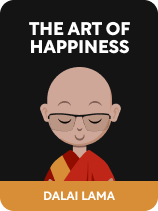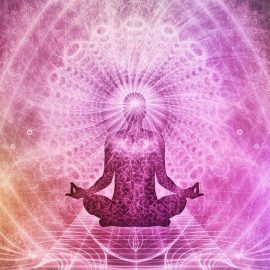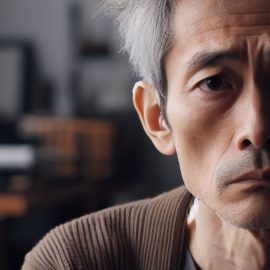

This article is an excerpt from the Shortform book guide to "The Art of Happiness" by Dalai Lama. Shortform has the world's best summaries and analyses of books you should be reading.
Like this article? Sign up for a free trial here .
Can you free yourself from suffering? How can embracing suffering help you free yourself from it?
According to Buddhism, suffering is inherent to human existence. That’s why the first step toward eliminating suffering is, paradoxically enough, to accept it. There are four strategies to embrace suffering: 1) don’t take things personally, 2) stop feeling guilty, 3) contemplate your mortality, and 4) stop resisting change.
Let’s explore each in more detail.
Strategy #1: Don’t Take Things Personally
To embrace suffering, stop taking things personally, advises the Dalai Lama. According to Cutler, humans tend to personalize—take events that have nothing to do with them, personally. To stop doing this, analyze problematic situations like a scientist, counsels the Dalai Lama. You’ll likely find the problem has less to do with you than you thought.
For instance, if a delivery person doesn’t deliver your package on the expected day, you might think they have a vendetta against you. But by analyzing the situation objectively, you discover there are postal delays. This, not a vindictive delivery person, is the source of the problem.
(Shortform note: The Dalai Lama counsels objectivity, but it’s hard to be objective when it comes to your own life. Foster objectivity by recognizing that you’ll never be completely objective and that the best you’ll ever do is approach objectivity. Also be aware of the areas of your life where objectivity is especially difficult—when it comes to parenting, for instance. Bring additional attention to such areas to stop taking things personally.)
Cutler notes that you won’t always be able to trace the source of every problem—you simply don’t have enough information. But by questioning why something bad happened, rather than leaping to conclusions, you begin to dismantle the belief that everything is about you.
(Shortform note: Personalization is one of several cognitive distortions that the act of questioning can help combat. Others include overgeneralization, which causes you to draw a broad conclusion from a small event, and catastrophizing, which leads you to blow up problems out of proportion. Bringing rational inquiry to such thought patterns can help prevent them from gaining traction.)
Strategy #2: Stop Feeling Guilty
Embrace suffering by refusing to indulge in guilt, insist Cutler and the Dalai Lama. Guilt is a form of suffering-denial: You refuse to accept that you, and all humans, make mistakes that cause suffering. Therefore, when you make a mistake that causes suffering, you feel it’s unacceptable and punish yourself by feeling guilty. Instead of stoking unconstructive feelings of guilt, approach mistakes as learning experiences, writes Cutler.
Let’s say you accidentally address a new acquaintance by the wrong name, which causes them to suffer. You spend the rest of the day beating yourself up over having used the wrong name, rather than accepting that accidental suffering is unavoidable, even when you create it, resolving to remember their name next time, and moving on.
(Shortform note: Cutler and the Dalai Lama advise you to cut out guilt, but in proper doses, guilt can help people behave appropriately. When people recalled behavior they felt guilty about in the past, they were more likely to improve their behavior moving forward than if they recalled behavior they hadn’t felt guilty about. Those who feel guilt easily also typically have a better work ethic and can lead more effectively than those who don’t. In some cases, guilt might therefore contain a learning component.)
Strategy #3: Contemplate Your Mortal Body
Grasp how integral suffering is to your existence by reflecting on the nature of your body, recommends the Dalai Lama. Simply by having a body, which experiences pain and feelings, you’re automatically subject to suffering.
(Shortform note: The Dalai Lama proposes that suffering is built into the human experience, but this isn’t the case in Christian teaching. Christians believe that God made the world perfect and free from suffering. It was humans who brought about suffering and evil by disobeying him.)
Strategy #4: Stop Resisting Change
Finally, embrace suffering by accepting change, say Cutler and the Dalai Lama. Nothing in life is permanent, and you cause yourself suffering by clinging to states, people, or objects that inevitably change. A clear-cut example of this is the process of aging. Many suffer because they can’t accept that their bodies deteriorate over time. It would be less painful to simply accept the changes brought about by aging.
(Shortform note: Accepting change can be difficult, especially in areas of our lives in which industries have a vested interest in making us feel that change is unacceptable. Author Ashton Applewhite argues that the skincare industry and the pharmaceutical industry make natural changes in appearance and physical ability seem unacceptable, so people buy the products they sell. Both society and we ourselves thus perpetuate our suffering.)
You can also make yourself miserable by thinking that a problem is permanent, when actually, nothing is permanent, writes Cutler. You might despair when you lose your job, for instance, because you see unemployment as lasting. Understanding that this state will probably change can reduce your suffering.
(Shortform note: Some argue that all Buddhist philosophy and teachings revolve around the acceptance of impermanence. If you can accept that all things must end—including, most importantly, life—you free yourself fully from suffering. Some Buddhist teachers go even further to say that you must not only accept impermanence but appreciate it. In other words, if a pet dies, don’t just accept their death—change—as a fact of life. Appreciate that life is change and that you’re currently experiencing life as the constantly-flowing river of change it is.)

———End of Preview———
Like what you just read? Read the rest of the world's best book summary and analysis of Dalai Lama's "The Art of Happiness" at Shortform .
Here's what you'll find in our full The Art of Happiness summary :
- The Dalai Lama's Buddhist path toward happiness
- The use of scientific evidence to support the Dalai Lama's beliefs
- Concrete actions you can take to improve your outlook on life, relationships, and resilience






